If temples could speak, the 108 Divya Desams would probably start with, “We’ve seen more than a thousand years go by — and we’re still standing.”
These sacred shrines of Lord Vishnu are not just stone and sculpture; they’re a living map of devotion, etched across India. Sung in the Nalayira Divya Prabandham by the Tamil poet-saints known as the Alvars, each temple is said to hold a piece of the universe’s wisdom — whether hidden in its architecture, whispered through its legends, or felt in the stillness of its sanctum.
Out of the 108 Divya Desams, two are believed to be beyond this physical world — one in the heavenly realm (Thirupaar Kadal) and one in Vaikuntha, the abode of Vishnu. Devotees believe you can “visit” them only through deep meditation or spiritual merit.
For centuries, kings, saints, traders, and ordinary villagers have crossed mountains, rivers, and kingdoms just to stand before the deity in each temple. Today, whether you’re a pilgrim tracing the footsteps of the Alvars or a curious traveller seeking history wrapped in myth, the Divya Desams offer something rare — a journey that feeds both the soul and the senses.
Table of Contents
What Are Divya Desams?
The term Divya Desam comes from Tamil — Divya meaning “divine” and Desam meaning “place” or “land.” Together, it refers to the 108 temples of Lord Vishnu that were glorified in the Tamil devotional hymns of the 12 Alvars — Poigai Alvar, Bhoothath Alvar, Pey Alvar, Thirumalisai Alvar, Nammalvar, Madhurakavi Alvar, Kulasekara Alvar, Periyalvar, Andal, Thondaradippodi Alvar, Thiruppaan Alvar, and Thirumangai Alvar — poet-saints who lived between the 6th and 9th centuries CE.
These temples are not random selections — each one was personally visited and sung about in the Nalayira Divya Prabandham, a collection of 4,000 sacred verses. In many ways, the Alvars were the first travel bloggers — except their “posts” were poetic praises, and their “followers” were generations of devotees who still retrace their journeys today.
The Divya Desams are spread across India and even beyond — from the towering Himalayas at Badrinath to the coastal beauty of Thiruvananthapuram, from the temple towns of Tamil Nadu to the riversides of Gujarat.
🔍 Myth Buster 🔍
Myth: “All 108 Divya Desams are in Tamil Nadu.”
Truth: While Tamil Nadu has the largest number, several are in Kerala, Andhra Pradesh, Uttar Pradesh, Gujarat, and even in Nepal (Muktinath). Two are believed to exist beyond Earthly realms — in the divine abode of Vishnu — and can only be experienced spiritually.
The Spiritual Significance of Visiting All 108
For many devotees, visiting all 108 Divya Desams isn’t just a checklist — it’s a spiritual marathon. Ancient belief holds that a pilgrim who completes this journey with sincerity is granted moksha — liberation from the cycle of birth and death. It’s not about the number, though. Each temple is said to hold a fragment of the cosmic truth, and together they form a complete spiritual map.
The journey tests more than faith. Some Divya Desams are easy to reach; others require crossing snowy Himalayan passes, taking boat rides across temple tanks, or climbing hundreds of stone steps in tropical heat. This physical challenge is considered symbolic of the effort needed to reach spiritual awakening.
📌 Do You Know? 📌
In Sri Vaishnavism, the pilgrimage to all 108 Divya Desams is called Divya Desa Yatra. The final temple many pilgrims visit is Srirangam, symbolizing the soul’s arrival at the eternal abode of Vishnu.
Interestingly, some devotees take decades to finish the pilgrimage — visiting temples whenever life allows, slowly stitching together their spiritual passport. Others dedicate a few intense years, mapping out the journey with military precision. Either way, the belief is the same: each temple is a chapter in the story of the soul’s return to the divine.
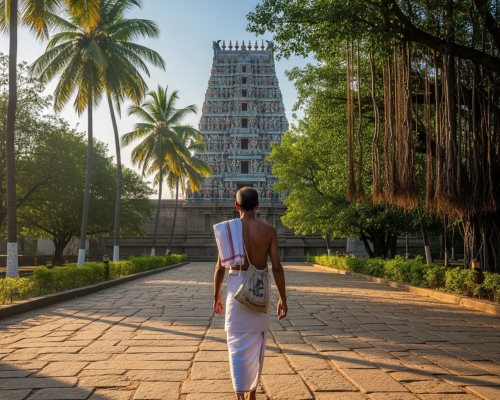
A Map of the Universe in Temples
The 108 Divya Desams are not just scattered randomly across India — many devotees believe their locations mirror the structure of the cosmos itself. From the icy peaks of Badrinath in the north to the coastal sanctuaries of Tirunelveli in the south, each temple is seen as a point in a divine map that connects heaven, earth, and everything in between.
In Vaishnavite tradition, the four directions represent different aspects of Vishnu — the protector, the sustainer, the giver of knowledge, and the remover of obstacles. Temples in each region reflect these qualities. For example, northern shrines often highlight Vishnu’s role as a cosmic preserver, while southern ones emphasize His intimate connection with devotees.
Some scholars see another pattern — a pilgrimage route that follows ancient trade paths. This means the Divya Desams didn’t just connect the spiritual world; they also connected people, ideas, and cultures across centuries.
| S.No. | Temple Name | Location (Town/City) | State / Country | Presiding Deity Form |
|---|---|---|---|---|
| 1 | Srirangam Ranganathaswamy Temple | Srirangam, Trichy district | Tamil Nadu | Ranganathaswamy Perumal and Ranganayaki Thayar |
| 2 | Thirukoḻi | Uraiyur, Trichy district | Tamil Nadu | Kamalavalli Nachiyar and Aḻagiya Manavala Perumal |
| 3 | Thirukkarambanoor | Uthamarkoil, Tiruchirappalli district | Tamil Nadu | Purushottama Nayaki and Purushottama Perumal |
| 4 | Pundarikakshan Perumal Koil | Thiruvellarai, Trichy district | Tamil Nadu | Pankaja Nayaki and Pundarikaksha Perumal |
| 5 | Vadivaḻagiya Nambi Perumal Koil | Anbil, Trichy district | Tamil Nadu | Saundaryavalli and Sundararaja Perumal |
| 6 | Appakkudathaan Perumal Koil | Koviladi, Tanjore district | Tamil Nadu | Indravalli and Appakudatthan Perumal |
| 7 | Hara Saabha Vimocchana Perumal Temple | Kandiyur, Thanjavur district | Tamil Nadu | Kamalavalli and Hara Saabha Vimochana Perumal |
| 8 | Thirukoodalur | Aduthurai, Thanjavur district | Tamil Nadu | Padmasani and Jagathrakshaga Perumal |
| 9 | Thirukavithalam | Kabisthalam, Thanjavur district | Tamil Nadu | Ramamanivalli and Gajendra Varadha Perumal |
| 10 | Thiruppullamboothangudi | Pullabhoothangudi, Thanjavur district | Tamil Nadu | Hemambujavalli and Rama Perumal |
| 11 | Thiruaadhanur | Adanur, Thanjavur district | Tamil Nadu | Ranganayaki Thayar and Andalukkum Aiyyan Perumal |
| 12 | Thirukudanthai | Kumbakonam, Thanjavur district | Tamil Nadu | Komalavalli and Aravamuda Perumal |
| 13 | Thiruvinnagar | Tirunageswaram, Thanjavur district | Tamil Nadu | Bhumidevi and Uppiliappan Perumal |
| 14 | Thirunaraiyur | Nachiyar Kovil, Thiruvarur district | Tamil Nadu | Vanchulavalli and Srinivasa Perumal |
| 15 | Thirucherai | Tirucherai, Thanjavur district | Tamil Nadu | Saranayaki and Saranatha Perumal |
| 16 | Thirukannamangai | Thirukannamangai, Thiruvarur district | Tamil Nadu | Abishekavalli and Bhaktavatsala Perumal |
| 17 | Thirukannapuram | Tirukannapuram, Nagapattinam district | Tamil Nadu | Kannapura Nayaki and Sowriraja Perumal |
| 18 | Thirukannangudi | Tirukannankudi, Nagapattinam district | Tamil Nadu | Loganayaki and Lokanatha Perumal |
| 19 | Thirunagai | Nagapattinam, Nagapattinam district | Tamil Nadu | Saundaryavalli and Sundararaja Perumal |
| 20 | Thiruthanjai Mamanikoil | Thanjavur, Thanjavur district | Tamil Nadu | Raktapankajavalli and Neelamegha Perumal |
| 21 | Thirunandhipura Vinnagaram | Nathan Kovil, Thiruvarur district | Tamil Nadu | Shenbagavalli and Jagannatha Perumal |
| 22 | Thiruvelliyangudi | Thiruvelliyangudi, Thanjavur district | Tamil Nadu | Maragadhavalli and Kolavilli Rama Perumal |
| 23 | Thiruvazhundur | Theranzhdur, Mayiladuthurai district | Tamil Nadu | Senkamalavalli and Sri Devadiraja Perumal |
| 24 | Thiruchirupuliyur | Thirusirupuliyur, Thiruvarur district | Tamil Nadu | Dayanayaki and Krupasamudra Perumal |
| 25 | Thiruthalaichanga Nanmadiyam | Thalachangadu, Mayiladuthurai district | Tamil Nadu | Thalaichanga Nachiyar and Chandrasaabahara Perumal |
| 26 | Thiruindalur | Indalur, Mayiladuthurai district | Tamil Nadu | Parimala Ranganayaki and Sri Parimala Ranganatha Perumal |
| 27 | Thirukkavalambadi | Thirunangur, Mayiladuthurai district | Tamil Nadu | Senkamala Nachiyar and Gopala Krishna Perumal |
| 28 | Thirukazhicheerama Vinnagaram | Sirkazhi, Mayiladuthurai district | Tamil Nadu | Lokanayaki and Trivikrama Perumal |
| 29 | Thiruarimeya Vinnagaram | Thirunangur, Mayiladuthurai district | Tamil Nadu | Amrudhagadavalli and Kudamudakoothan Perumal |
| 30 | Thiruvanpurushothamam | Thirunangur, Mayiladuthurai district | Tamil Nadu | Purushotthama Nayaki and Purushottama Perumal |
| 31 | Thirusemponsaikoil | Thirunangur, Mayiladuthurai district | Tamil Nadu | Sweda Pushpavalli and Hemaranganatha Perumal |
| 32 | Thirumanimadakoil | Thirunangur, Mayiladuthurai district | Tamil Nadu | Pundareegavalli and Sashvatha Deepaya Narayana Perumal |
| 33 | Thiruvaikunta Vinnagaram | Thirunangur, Mayiladuthurai district | Tamil Nadu | Vaikundavalli and Vaikundanatha Perumal |
| 34 | Thiruvali | Thiruvali, Mayiladuthurai district | Tamil Nadu | Amrudhagadavalli and Kedarapathivaraya Perumal |
| 35 | Thirunagari | Thirunagari, Mayiladuthurai district | Tamil Nadu | Amurdha Valli and Devaraja Perumal |
| 36 | Thiruthevanarthogai | Thirunangur, Mayiladuthurai district | Tamil Nadu | Samudradanaya and Devanayaka Perumal |
| 37 | Thiruthetriambalam | Thirunangur, Mayiladuthurai district | Tamil Nadu | Rakthapankajavalli and Lakshmiranga Perumal |
| 38 | Thirumanikoodam | Thirunangur, Mayiladuthurai district | Tamil Nadu | Boonayagi and Varadharaja Perumal |
| 39 | Thiruvellakulam | Thirunangur, Mayiladuthurai district | Tamil Nadu | Padmavathi and Srinivasa Perumal |
| 40 | Thiruparthanpalli | Parthanpalli, Mayiladuthurai district | Tamil Nadu | Tamarai Nayagi and Taamaraiyaal Kelvan Perumal |
| 41 | Thiruchitrakoodam | Chidambaram, Cuddalore district | Tamil Nadu | Pundareekavalli and Govindaraja Perumal |
| 42 | Thiruvanthipuram | Thiruvanthipuram, Cuddalore district | Tamil Nadu | Hemambujavalli and Devanatha Perumal |
| 43 | Thirukkoyilur | Thirukoyilur, Kallakurichi district | Tamil Nadu | Pushpavalli and Trivikrama Perumal |
| 44 | Thirukkachi - Atthigiri | Kanchipuram, Kanchipuram district | Tamil Nadu | Perundevi Thayar and Varadharaja Perumal |
| 45 | Ashtabujagaram | Kanchipuram, Kanchipuram district | Tamil Nadu | Padmasani and Ashtabhuja Perumal |
| 46 | Thiruthanka | Kanchipuram, Kanchipuram district | Tamil Nadu | Maragadhavalli and Deepaprakasa Perumal |
| 47 | Thiruvelukkai | Kanchipuram, Kanchipuram district | Tamil Nadu | Amritavalli and Yoga Narasimha Perumal |
| 48 | Thiruneeragam | Kanchipuram, Kanchipuram district | Tamil Nadu | Nilamangai Valli and Jagadeesha Perumal |
| 49 | Thiruppadagam | Kanchipuram, Kanchipuram district | Tamil Nadu | Rukmini and Pandavadootha Perumal |
| 50 | Nilathingal Thundam | Kanchipuram, Kanchipuram district | Tamil Nadu | Chandrasoodavalli and Chandrasooda Perumal |
| 51 | Thiruooragam | Kanchipuram, Kanchipuram district | Tamil Nadu | Amudavalli and Trivikrama Perumal |
| 52 | Thiruvekka | Kanchipuram, Kanchipuram district | Tamil Nadu | Komalavalli and Yathottakari Perumal |
| 53 | Thirukkaragam | Kanchipuram, Kanchipuram district | Tamil Nadu | Padmamani and Karunagara Perumal |
| 54 | Thirukkarvaanam | Kanchipuram, Kanchipuram district | Tamil Nadu | Kamalavalli and Neelamega Perumal |
| 55 | Thirukkalvanur | Kanchipuram, Kanchipuram district | Tamil Nadu | Anjilai Valli and Adi Varaha Perumal |
| 56 | Thiruppavalavannam | Kanchipuram, Kanchipuram district | Tamil Nadu | Pavalavalli and Pavalavarna Perumal |
| 57 | Thiru Parameswara Vinnagaram | Kanchipuram, Kanchipuram district | Tamil Nadu | Vaikundavalli and Vaikundanatha Perumal |
| 58 | Thiruputkuzhi | Thiruputkuzhi, Kanchipuram district | Tamil Nadu | Maragadhavalli and Vijayaraghava Perumal |
| 59 | Thirunindravur | Thirunindravur, Chennai, Tiruvallur District | Tamil Nadu | Sudhavalli and Bhaktavatsala Perumal |
| 60 | Thiruvallur | Thiruvallur, Chennai, Tiruvallur district | Tamil Nadu | Kanakavalli and Vaidya Veeraraghava Perumal |
| 61 | Thiruvallikeni | Chennai, Chennai district | Tamil Nadu | Rukmini and Venkatakrishna Perumal |
| 62 | Thiruneermalai | Kanchipuram, Kanchipuram district | Tamil Nadu | Animamalar Mangai and Neervanna Perumal |
| 63 | Thiruvidanthai | Thiruvidanthai, Chennai, Kanchipuram district | Tamil Nadu | Komalavalli and Nityakalyana Perumal |
| 64 | Thirukkadanmallai | Mahabalipuram, Kanchipuram district | Tamil Nadu | Boosthalamangadevi and Sthalasayana Perumal |
| 65 | Thirukkadigai | Sholinghur, Vellore district | Tamil Nadu | Amritavalli and Yoga Narasimha Perumal |
| 66 | Thiruvattaru | Thiruvattar, Kanyakumari district | Tamil Nadu | Maragadhavalli and Adhikesava Perumal |
| 67 | Thirukkurungudi | Thirukkurungudi, Tirunelveli district | Tamil Nadu | Vamanakshetravalli and Vamanakshetrapoornaya Perumal |
| 68 | Thirucheeravaramangai | Nanguneri, Tirunelveli district | Tamil Nadu | Chireevaramangaivalli and Thothadhrinatha Perumal |
| 69 | Thiruvaigundam | Srivaikuntam, Thoothukudi district | Tamil Nadu | Boonayagi, Vaigundavalli and Vaikuntanatha Perumal |
| 70 | Thiruvaragunamangai | Natham, Thoothukudi district | Tamil Nadu | Varagunavalli and Vijayasana Perumal |
| 71 | Thiruppuliangudi | Thirupulingudi, Thoothukudi district | Tamil Nadu | Malarmagal Nachiyar and Poomagal Nachiyar and Kaaichina Vendhan Perumal |
| 72 | Thirutholaivillimangalam (Navathirupathi) | Tholavillimangalam, Thoothukudi district | Tamil Nadu | Karunthadanganni Nachiyar and Aravindalochana Perumal |
| 73 | Thirukkulandai (Navathirupathi) | Perungulam, Thoothukudi district | Tamil Nadu | Alamelumangai Thayar and Kulandhai Valli and Srinivasa Perumal |
| 74 | Thirukkolur (Navathirupathi) | Thirukolur, Thoothukudi district | Tamil Nadu | Amudhavalli and Koloorvalli and Vaithamanithi Perumal |
| 75 | Thirupperai | Thenthiruperai, Thoothukudi district | Tamil Nadu | Kuḻaikkadhu Valli, and Thirupperai Nachiyar and Magara Nedungkuḻai Kathar Perumal |
| 76 | Thirukkurugur | Alwarthirunagari, Thoothukudi district | Tamil Nadu | Aadhinadha Valli and Gurukoor valli and Aadhinatha Perumal |
| 77 | Srivillipputhur | Srivilliputhur, Virudhunagar district | Tamil Nadu | Kodhadevi and Vatapatrasayee Perumal |
| 78 | Thiruthangal | Thiruthankal Virudhunagar district | Tamil Nadu | Sengamala Thayar and Narayana Perumal |
| 79 | Thirukkoodal | Madurai, Madurai district | Tamil Nadu | Madhuravalli Thayar and Koodal Aḻagar Perumal |
| 80 | Thirumaliruncholai | Alagar Koyil, Madurai district | Tamil Nadu | Sundaravalli and Kallaḻagar Perumal |
| 81 | Thirumogur | Thirumohur, Madurai district | Tamil Nadu | Mohavalli and Kalamega Perumal |
| 82 | Thirukkoshtiyur | Thirukoshtiyur, Sivaganga district | Tamil Nadu | Mahalakshmi and Uraga Mellanayaan Perumal |
| 83 | Thiruppullani | Thirupullani, Ramanathapuram district | Tamil Nadu | Kalyanavalli, Padmasani and Kalyana Jagannatha Perumal |
| 84 | Thirumeyyam | Thirumayam, Pudukottai district | Tamil Nadu | Uyya Vandha Nachiyar and Sathyagirinatha Perumal |
| 85 | Thirunavai | Tirunavaya, Mallapuram district | Kerala | Malarmangai and Navamukunda Perumal |
| 86 | Thiruvithuvakodu | Thiruvithuvakoodu, Palakkad district | Kerala | Vithuvakoduvalli and Abhayapradhaya Perumal |
| 87 | Thrikkakara Vamanamoorthy Kshethram (Thirukatkarai) | Thrikkakara, Ernakulam district | Kerala | Vathsalyavalli and Katkaraswami Perumal |
| 88 | Thirumoozhikkalam | Thirumoozhikulam, Ernakulam district | Kerala | Madhuraveni and Sookthinatha Perumal |
| 89 | Sree Vallabha Temple (Thiruvallavazh) | Thiruvalla, Pathanamthitta district | Kerala | Vathsalyavalli and Vallabhaswami Perumal |
| 90 | Thrikodithanam Mahavishnu Temple (Thirukkodithanam) | Thrikkodithanam, Changanassery, Kottayam District | Kerala | Karpagavalli and Amruthanarayana Perumal |
| 91 | Thrichittatt Mahavishnu Temple (Thiruchengundrur) | Chengannur, Alappuzha District | Kerala | Rakthapankajavalli and Devathideva Perumal |
| 92 | Thiruppuliyur | Thripuliyur, Alappuzha District | Kerala | Porkodi Nachiyar and Maayapiran Perumal |
| 93 | Aranmula Parthasarathy Temple (Thiruvaranvilai) | Aranmula, Pathanamthitta District | Kerala | Padmasani Nachiyar and Kuralappan Perumal |
| 94 | Thiruvanvandoor | Thiruvanvandoor, Alappuzha District | Kerala | Kamalavalli Nachiyar and Paambanaiyappan Perumal |
| 95 | Thiruvananthapuram | Thiruvananthapuram, Thiruvananthapuram District | Kerala | Harilakshmi and Ananthapadmanabhaswami Perumal |
| 96 | Thiruvayodhi (Ayodhya) | Sai Nagar, Ayodhya | Uttar Pradesh | Seethadevi and Ramachandra Perumal |
| 97 | Naimisaranyam | Misrikh Neemsar | Uttar Pradesh | Harilakshmi and Devaraja Perumal |
| 98 | Thiruvadamadurai (Krishna Janmabhoomi) | Mathura, Mathura district | Uttar Pradesh | Satyabama and Govardhanagiridhari Perumal |
| 99 | Thiruvaipadi (Gokula) | Gokul, Mathura district | Uttar Pradesh | Rukmini, Sathyabama, and Navamohanakrishna Perumal |
| 100 | Thirupruthi (Jyothirmath) | Jyotirmath, Chamoli district | Uttarakhand | Parimalavalli and Paramapurusha Perumal |
| 101 | Thirukkandamenum Kadinagar | Devaprayag, Tehri Garhwal district | Uttarakhand | Pundareegavalli and Purushottama Perumal |
| 102 | Thiruvadari (Badrinath) | Badrinath, Chamoli district | Uttarakhand | Aravindhavalli and Badrinarayana Perumal |
| 103 | Ahobilam | Ahobilam, Kurnool district | Andhra Pradesh | Lakshmi and Prahlada Varada Narasimha swamy |
| 104 | Thiruvenkadam | Tirupati, Chittoor district | Andhra Pradesh | Padmavati and Srinivasa Perumal |
| 105 | Thirudwarakai (Dwarakadheesh) | Dwarka, Devbhoomi Dwarka district | Gujarat | Rukmini and Dwarakadheesha Perumal |
| 106 | Thiru Saligram (Muktinath) | Muktinath Valley Mustang District | Nepal | Sridevi and Srimurti Perumal |
| 107 | Tirupparkatal (Kshira Sagara) | Heaven | Heaven | Kadal Magal and Parkadal Natha Perumal |
| 108 | Tirupparamapadam (Vaikuntha) | Vaikuntha | Vaikuntha | Paramapada Nayaki and Paramapada Nathan |
Legends & Mysteries Behind Some Divya Desams
While every Divya Desam has its own charm, a few stand out for the sheer depth of their legends — stories that blur the line between history and divine play.
1. Srirangam Ranganathaswamy Temple, Tamil Nadu
According to legend, the main deity here — Ranganatha reclining on Adisesha — was originally worshipped by Lord Brahma in Satya Loka. It was gifted to King Ikshvaku of the Solar Dynasty, passed down to Rama, and eventually given to Vibhishana after the Ramayana war. When Vibhishana carried it towards Lanka, the idol “chose” to stay in Srirangam, making it one of the holiest Vishnu shrines on Earth.
📌 Do You Know? 📌
The temple has seven concentric enclosures — said to represent the seven layers of the universe.

Sri Ranganathaswamy Temple, Srirangam
Image Credit: Lodo from Moscow, Russia, CC BY-SA 2.0, via Wikimedia Commons
https://commons.wikimedia.org/wiki/File:Ranganathaswamy_Temple,Srirangam(49998238702).jpg
2. Padmanabhaswamy Temple, Thiruvananthapuram, Kerala
This temple is famous for its deity in an Anantha Shayana (reclining) posture, but its bigger mystery lies underground. In 2011, unopened vaults beneath the temple revealed treasures worth billions — ancient gold coins, ornaments, and artefacts — making it one of the richest temples in the world according to Britannica. One vault (Vault B) remains sealed to this day, believed to be protected by a divine curse.
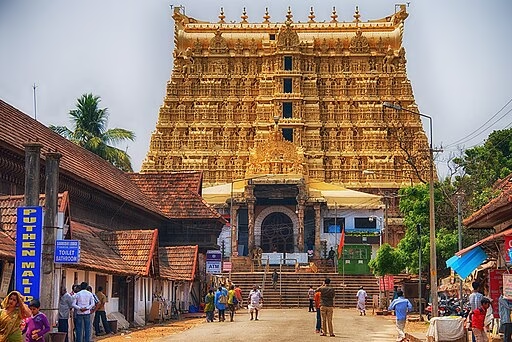
Sri Padmanabhaswamy Temple, Thiruvananthapuram
Image Credit: Alaison bennny, CC BY-SA 4.0, via Wikimedia Commons
https://commons.wikimedia.org/wiki/File:Sree_Padmanabhaswamy_temple_Thiruvananthapuram,.jpg
3. Badrinath Temple, Uttarakhand
Nestled in the Himalayas, Badrinath is said to be where Vishnu meditated while his consort, Lakshmi, shielded him from the elements by taking the form of a Badri tree. The temple opens only six months a year due to extreme weather, and locals believe celestial beings worship the deity during its closed months.
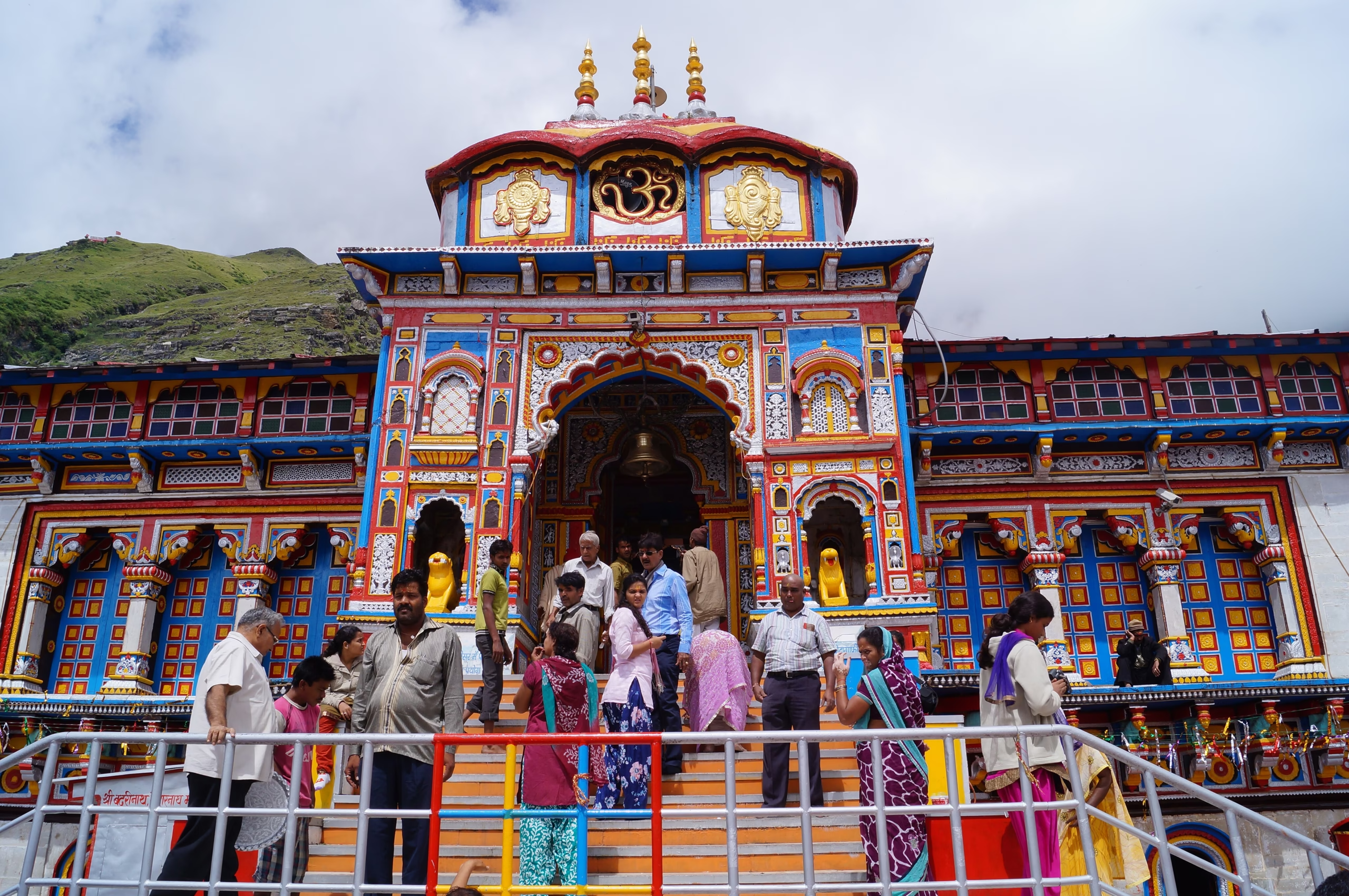
Badrinath Temple, Uttarakhand
Image Credit: Ketan0212, CC BY-SA 3.0, via Wikimedia Commons
https://commons.wikimedia.org/wiki/File:Badrinath_temple_entrance.JPG
4. Srivilliputhur Andal Temple, Tamil Nadu
This temple is dedicated to Andal, the only female Alvar. Found as a baby under a Tulsi plant by Periyalvar, Andal grew up weaving garlands for the Lord. In a rare act of devotion, she is believed to have merged with Ranganatha in Srirangam, becoming one with the divine. The temple’s gopuram is so iconic that it features on the Tamil Nadu state emblem.
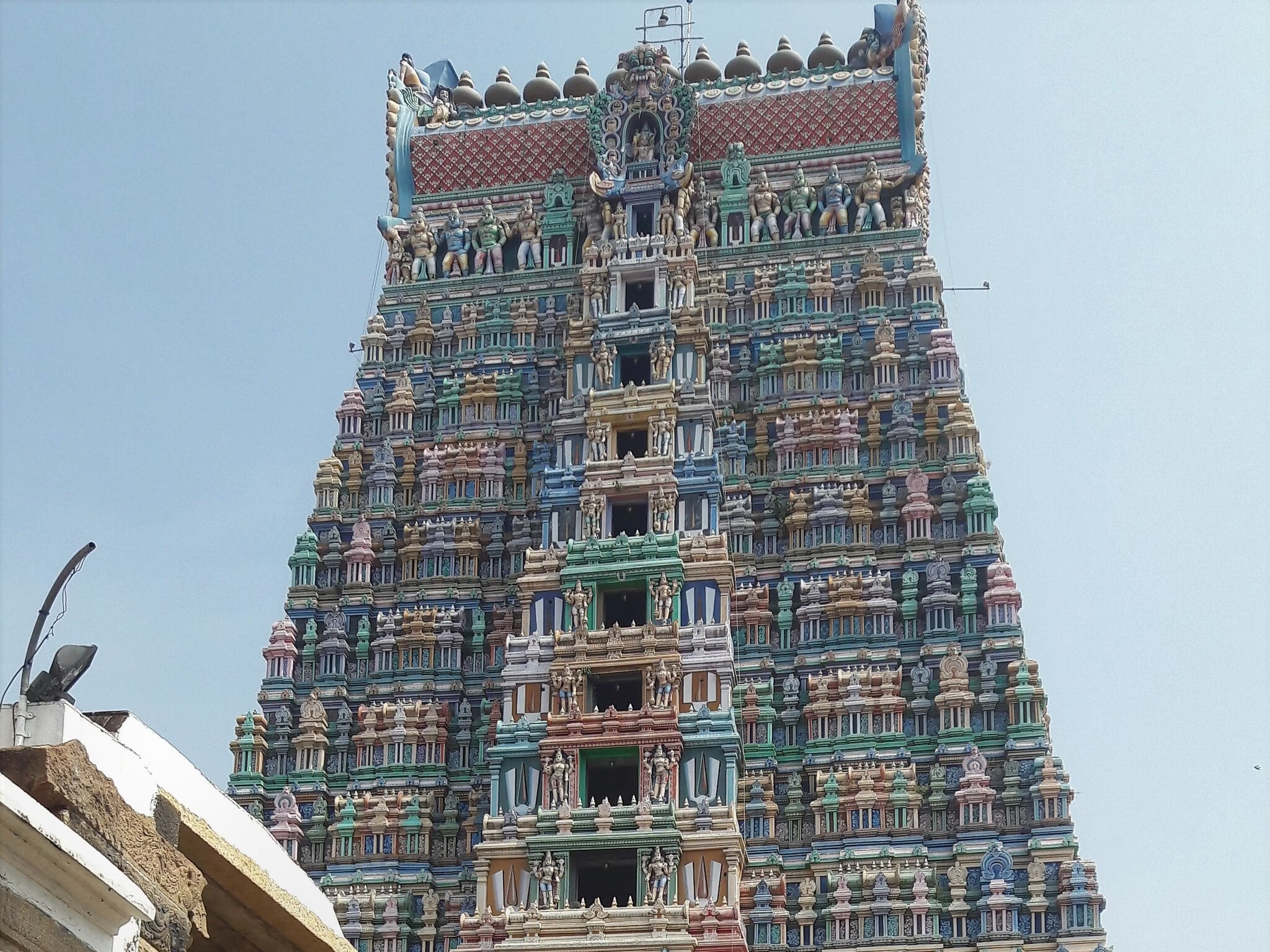
Srivilliputhur Andal Temple, Tamil Nadu
Image Credit: Ssriram mt, CC BY-SA 4.0, via Wikimedia Commons
https://commons.wikimedia.org/wiki/File:Srivilliputhur_Andal_temple_(29).jpg
5. Thirumala Tirupati, Andhra Pradesh
Though not always listed as a separate Divya Desam (it is part of the 106 earthly ones), Tirupati’s legend says Vishnu descended here to save humanity from the trials of Kali Yuga. The daily rituals include a secret recipe for laddu prasadam, unchanged for over 300 years — a closely guarded temple secret.
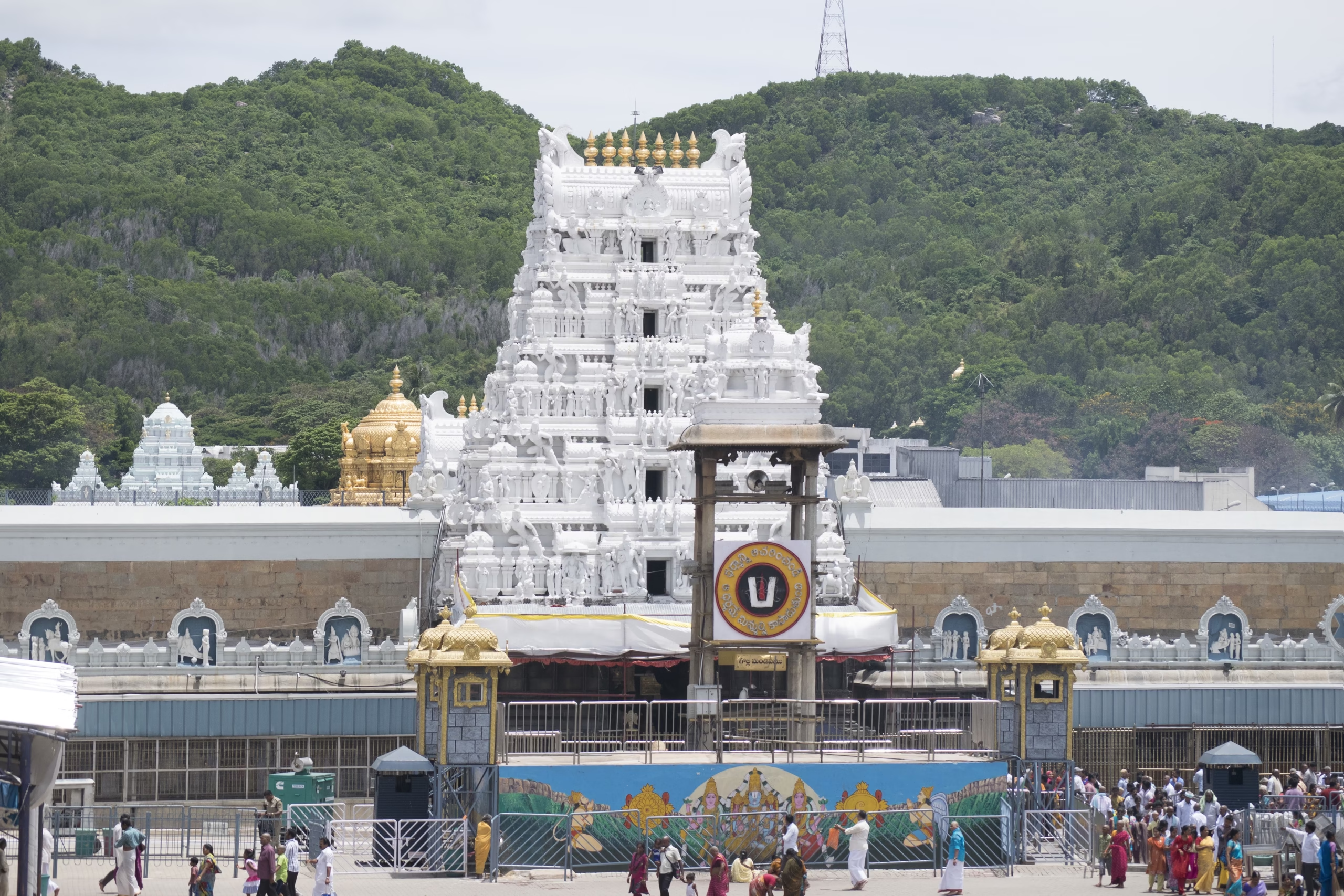
Thirumala Tirupati, Andhra Pradesh
Image Credit: Nikhil B/Wikimedia Commons, CC BY-SA 4.0, via Wikimedia Commons
https://commons.wikimedia.org/wiki/File:Tirumala_090615.jpg
How to Plan Your Divya Desam Journey
If the stories of the Divya Desams have stirred something in you, the next thought is simple: How do I visit them? With 108 temples spread across India, planning wisely can turn your trip into a seamless spiritual adventure instead of a tiring checklist.
1. Start by Grouping the Temples by Region
Traditionally, Divya Desams are grouped into five main regions:
- Chola Nadu (40 temples): Cantered around Kumbakonam, Thanjavur, and Mayiladuthurai. This is the densest cluster and can easily fill a week-long trip.
- Nadu Nadu (2 temples): Found in Cuddalore and Tirukoilur, perfect for adding to your Tamil Nadu circuit.
- Pandya Nadu (18 temples): Based around Madurai, Tirunelveli, and surrounding areas.
- Kerala (13 temples): Spread across Trivandrum to Thrissur. Temples here often have unique architectural styles and rituals.
- Vada Nadu (Northern Tamil Nadu, 11 temples): Includes the sacred Badrinath and Dwarka, making this region the longest journey for most pilgrims.
A practical approach: focus on one region at a time instead of rushing to cover too many states in one trip.
2. Best Time to Visit
- Tamil Nadu clusters (Chola, Nadu, Pandya Nadu): November to February offers pleasant weather.
- Kerala temples: December to March is ideal, after the monsoons.
- Northern Divya Desams (like Badrinath): Only accessible from May to October due to snowfall.
- Festive times: Vaikunta Ekadasi, Panguni Uthiram, and Brahmotsavams are ideal for both darshan and vibrant temple culture.
3. Travel + Pilgrimage Balance
Remember, many temples are in small villages with limited transport. Combine them with nearby city temples to avoid fatigue. For example:
- In Kumbakonam, you can cover 10+ temples in short distances.
- In Madurai, plan Tirupparamkunram and Tirumogur alongside the main Meenakshi temple.
This way, you’re not just temple-hopping but also absorbing local culture, food, and the spiritual rhythm of each town.
4. A Pilgrim’s Tip
Carry a small notebook to jot down each temple you visit. Many devotees treat it as a “personal Divya Desam diary”, marking the date, the deity’s darshan, and any special memory. Years later, this diary becomes a priceless spiritual keepsake.
📌 Do You Know? 📌
The farthest Divya Desam from Tamil Nadu is Badrinath in Uttarakhand — almost 2,800 km away! Pilgrims often treat it as the final crown jewel of their Divya Desam journey.
This way, your Divya Desam Yatra is not just about ticking names off a list but experiencing the divine footprints left across India’s spiritual geography.
Sample 5-Day Chola Nadu Divya Desam Trail
If you’re planning your very first Divya Desam journey, starting with the Chola Nadu region (around Kumbakonam & Thanjavur in Tamil Nadu) is ideal. Many temples are close together, so you can cover several in a few days without exhausting travel.
Day 1 – Arrival & Warm-up (Kumbakonam)
- Arrive in Kumbakonam (well connected by train/bus).
- Visit Sarangapani Temple (the biggest Divya Desam in the region).
- Evening darshan at Ramaswamy Temple.
- Overnight stay in Kumbakonam.
Day 2 – Kumbakonam Cluster
- Early morning: Chakrapani Temple & Koodalazhagar Temple.
- Afternoon: Nachiyar Kovil (unique as Goddess Andal holds more importance here).
- Evening: Thirunaraiyur Nambi Temple.
- Stay overnight in Kumbakonam.
Day 3 – Thanjavur Side
- Travel to Thanjavur (~1 hr).
- Morning darshan at Thirukandiyur (Harasaapa Vimochana Perumal).
- Afternoon: Thirukkoodalur (temple linked to river Kaveri legends).
- Evening: Explore Thanjavur Big Temple (not a Divya Desam, but unmissable for heritage).
- Stay overnight in Thanjavur.
Day 4 – Srirangam Pilgrimage
- Early morning drive (~2 hrs) to Sri Ranganathaswamy Temple, Srirangam – the crown jewel of Divya Desams.
- Spend the whole day here, as the temple is massive and rituals happen throughout.
- Optional evening visit to Thiruvellarai (Pundarikakshan Perumal) nearby.
- Stay overnight in Trichy.
Day 5 – Wrap-up & Departure
- Morning darshan at Thirukkarambanur (Kamalavalli Nachiyar Temple).
- Visit Uraiyur Vekkali Amman Temple (not Divya Desam, but culturally significant).
- Depart from Trichy by train/flight.
Why this works for first-timers:
- Covers 10+ Divya Desams in a compact loop.
- Mixes famous temples (Srirangam, Sarangapani) with less-crowded gems.
- Easy travel circuit (Kumbakonam → Thanjavur → Srirangam/Trichy).
- Balances devotion with cultural sightseeing.
Why These Temples Still Matter Today?
It’s easy to look at the 108 Divya Desams as just ancient monuments, but step inside any of these temples and you’ll realize they are still alive with meaning. The chants, the sculptures, and the rituals are not just remnants of the past — they’re reminders of timeless wisdom. In a world that feels increasingly rushed, these temples show us the value of slowing down, reconnecting with faith, and finding balance.
More than just spiritual centres, Divya Desams are living museums of art, architecture, and literature. The hymns of the 12 Alvars echo themes of humility, love, and surrender — values that resonate deeply even in modern times. Whether you’re religious or not, the experience of standing where centuries of devotion have accumulated is profoundly grounding.
At the same time, visiting these temples is also about preserving cultural heritage. Every ritual performed, every inscription protected, and every devotee who continues the journey helps keep a 2,000-year-old tradition alive. Supporting these temples —whether through visits, donations, or even sharing knowledge about them — is part of ensuring that the stories of the Divya Desams continue to inspire future generations.
📌 Do You Know? 📌
Some Divya Desams, like the Parakala Narasimha temple in Mysuru, still preserve manuscripts and Vedic traditions that are studied by scholars today. They’re not just places of worship — they’re centers of living knowledge.
Conclusion
The 108 Divya Desams are not just ancient temples; they are living reminders that faith and culture can survive the test of time. Standing before these shrines, you don’t just see stone carvings — you feel the devotion of countless generations who believed that these were places where the divine truly walked among them.
If you ever find yourself near a Divya Desam, don’t rush. Sit for a while, listen to the chants, watch the lamps flicker, and let the atmosphere sink in. It’s in those quiet moments that you realize these temples are more than history — they are bridges between our present lives and the wisdom of the past.
Visiting even one Divya Desam can leave you with a sense of grounding that modern life rarely gives. And if you take the time to explore a few more, you might just find that the journey itself becomes as transformative as the destination.
Whether you’re a spiritual seeker, a history lover, or just a curious traveller, start with one Divya Desam that calls to you. Who knows — this single step may open the door to a lifelong journey of discovery.
And if you’ve already visited one, share your experience — it might just inspire someone else to begin their own.
✨ Want to dive deeper? Explore more hidden gems of India in our Sacred Places Archive — a collection of timeless journeys that connect history, faith, and culture. ✨
Frequently Asked Questions – FAQs
How many Divya Desams are there?
There are 108 Divya Desams in total, spread across India (and one in Nepal). Most are in Tamil Nadu, which is considered the heartland of Vaishnavite tradition.
Do I need to visit all 108 to complete the Divya Desam pilgrimage?
Traditionally, yes. Devotees believe that visiting all 108 temples fulfills the ultimate Vaishnava pilgrimage. But even starting with one region, like the Chola Nadu cluster, can be a powerful experience.
What’s the best time to visit Divya Desams?
October to March is ideal — pleasant weather, festive temple celebrations, and easier travel. Summers can be harsh, especially in Tamil Nadu.
Are these temples accessible for modern travellers?
Yes. Many Divya Desams are well-connected by rail and road. Larger towns like Kanchipuram, Srirangam, and Madurai serve as hubs. For smaller or rural temples, hiring a local auto or cab is best.
Where can I learn about other sacred places beyond Divya Desams?
If you’re curious about temples, shrines, and hidden spiritual sites across India, check out our Sacred Places Archive—a growing collection of journeys that blend history, devotion, and culture.
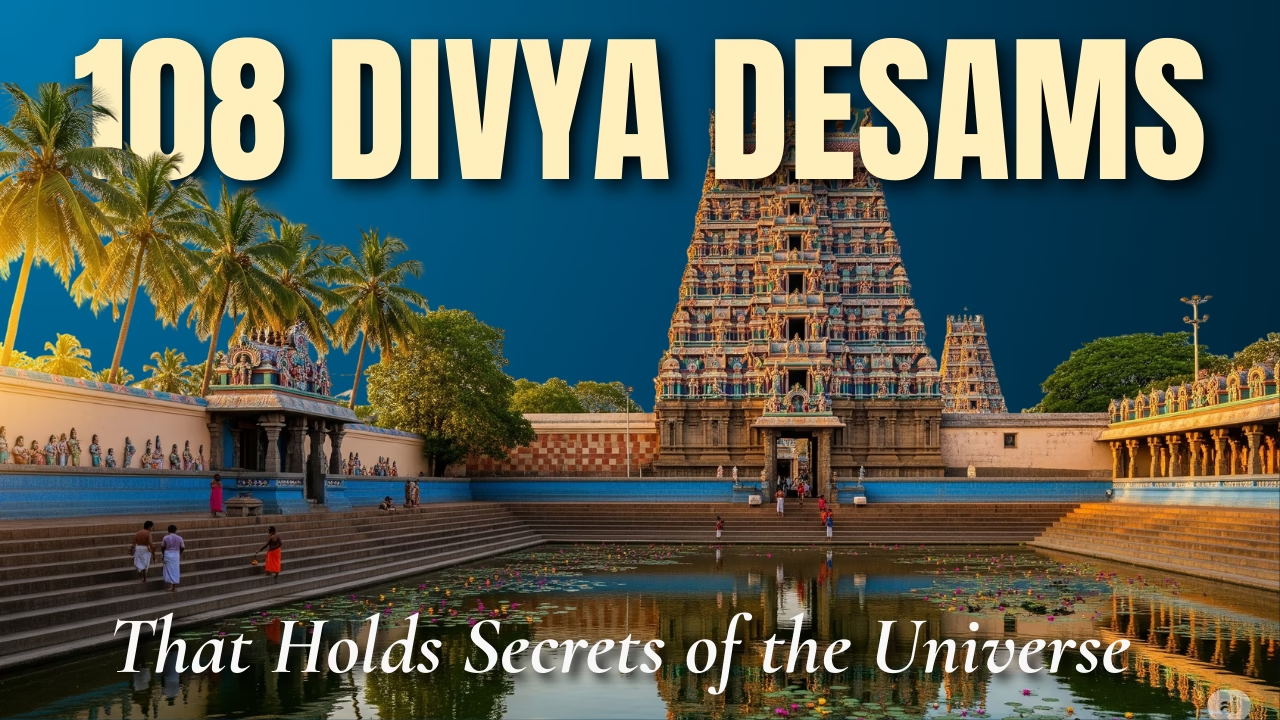



I oftentimes encounter information sites such as
this at the most unexpected times. Like right now, I had been hunting for a specific thing on an entirely different issue
and I encountered this website in fact. I oftentimes like searching online for articles, on the other hand for the most part I prefer to be out of doors, experiencing the outdoors in the regional forest land.
You’ll find nothing similar to clean air to cause you to truly feel invigorated.
This can be whenever i am not functioning as an at home massage therapist.
That occupies virtually all of my spare time.